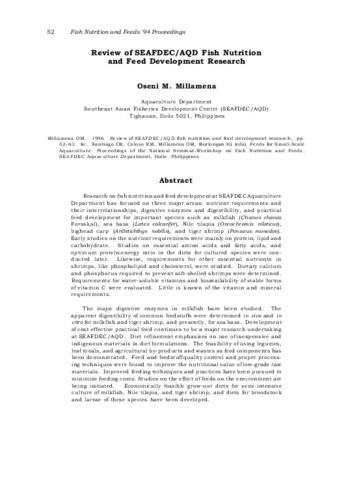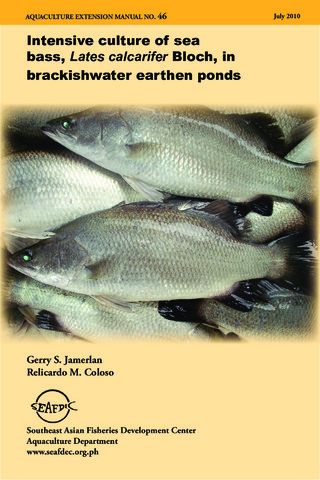Localization of enzymes in the digestive tract during the larval to early juvenile stages of sea bass (Lates calcarifier Bloch)
- Global styles
- MLA
- Vancouver
- Elsevier - Harvard
- APA
- Help
Share
抄録
The onset of digestive enzymes in the various regions of the digestive tract of sea bass, Lates calcarifer (Bloch) at days 0. 2, 5, 10, 20, 30, and 40 after hatching was investigated. This study aims to correlate which enzymes are detectable in stated regions of the developing gut and to relate this pattern to the feeding habit of sea bass. Alkaline phosphatase and esterase were localized in the intestine of the 2 day old larvae. At 5 days post-hatching, esterase was present in the esophagus. At the beginning of metamorphosis (20-days post-hatching), alkaline phosphatase, esterase, and amino peptidase were localized in the pyloric caeca. Aminopeptidase's and lipase were observed in the brush border of the intestinal epithelial cells. At the end of metamorphosis (30-days-post-hatching), all enzymes investigated in this study were present. Esterase was demonstrated in the columnar cells of the stomach while lipase and amylase were observed in both columnar cells and gastric glands. Protease and amylase were present in the pyloric caeca and intestine. During the early juvenile stage (40-days-post-hatching), esterase was localized in the gastric glands of the stomach. The appearance of esterase activity as early as day 2 was correlated with endogenous to zooplanktivorous feeding. In the same manner, the presence of aminopeptidase's, lipase, protease, and amylase at day 20 to 30 onwards was related to a change in feeding habit of sea bass from zooplanktivorous to real carnivorous. The findings of this study demonstrate the need for basic studies for feed formulation and management of the fish.
Keywords
digestive enzymes sea bass larvae enzyme activitySubjects
Digestive enzymesSuggested Citation
Minjoyo, H., Tan-Fermin, J. D., & Macaranas, J. M. (2003). Localization of enzymes in the digestive tract during the larval to early juvenile stages of sea bass (Lates calcarifier Bloch). Indonesian Fisheries Research Journal , 9(1), 46-53. http://hdl.handle.net/10862/6569
Type
ArticleISSN
0853-8980Collections
- Journal Articles [1229]
Related items
Showing items related by title, author, creator and subject.
-
Review of SEAFDEC/AQD fish nutrition and feed development research
Millamena, Oseni M. (Aquaculture Department, Southeast Asian Fisheries Development Center, 1996)Research on fish nutrition and feed development at SEAFDEC Aquaculture Department has focused on three major areas: nutrient requirements and their interrelationships, digestive enzymes and digestibility, and practical ... -
Ammonia excretion rates of the sea bass, Lates calcarifer, in fresh and sea water
Almendras, Jesus Manolo E. (Society of Israeli Aquaculture and Marine Biotechnology, 1994)The weight-specific ammonia excretion rate of sea bass (Lates calcarifer) fry in fresh water is higher than that of those in sea water. The allometric equation \(y = 24.426 \times ^{-0.4714}\) best describes the relationship ... -
Series: Aquaculture extension manual; No. 46
Intensive culture of sea bass, Lates calcarifer Bloch, in brackishwater earthen ponds
Jamerlan, Gerry S.; Coloso, Relicardo M. (Aquaculture Department, Southeast Asian Fisheries Development Center, 2010)An extension manual describing criteria for site selection, monoculture and polyculture operations including feeds and feeding, harvest, common diseases, economic analysis.







